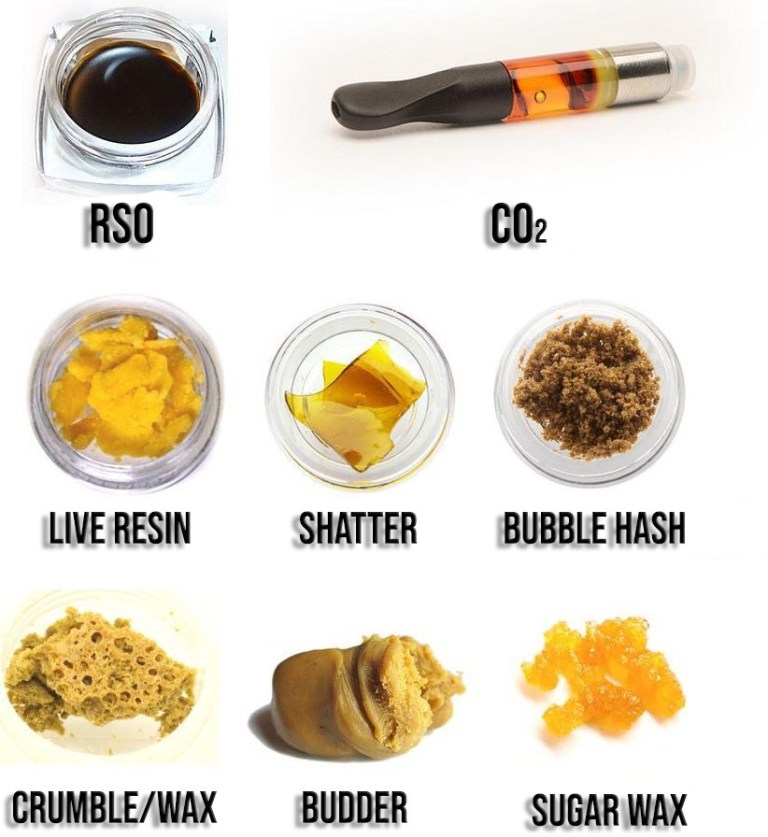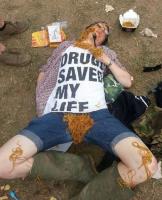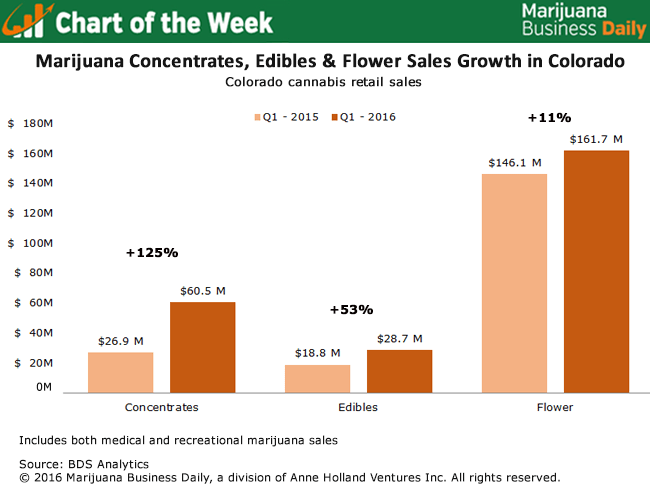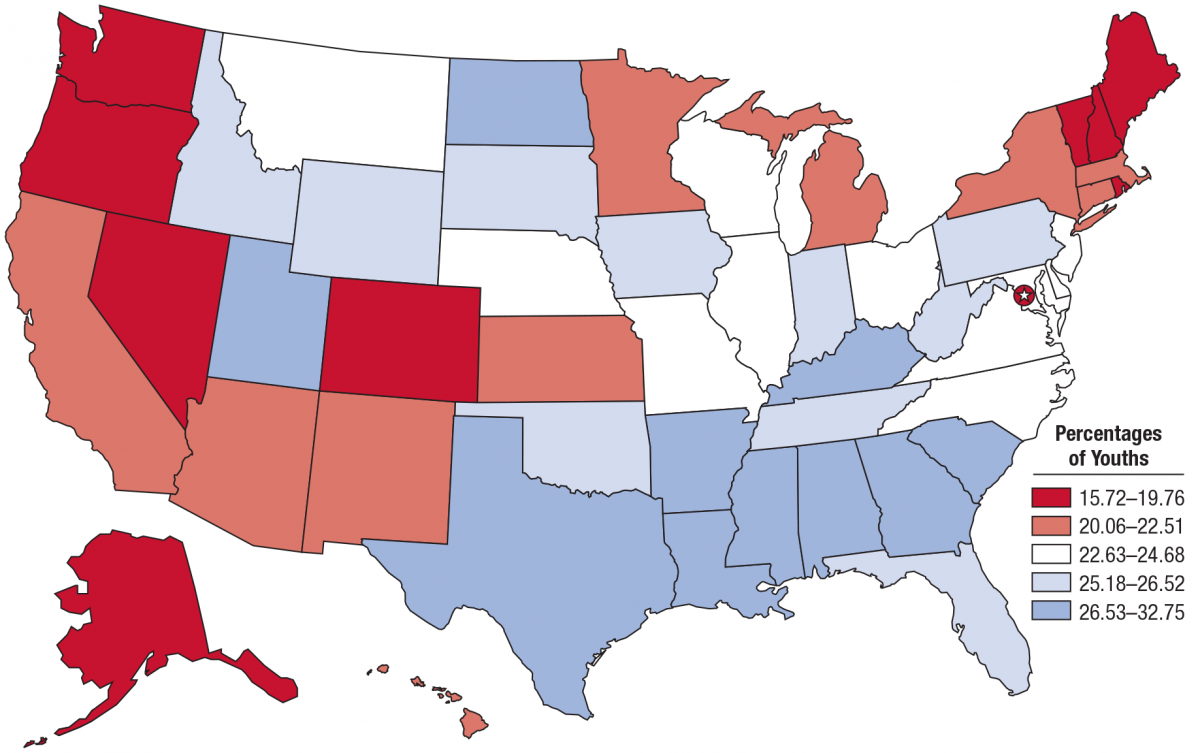Articles
Select or Type a Tag in the box or Click on Tag to retrieve all articles containing the desired tag topic.
| Link | Tags | |
|---|---|---|
|
The Legalization of Marijuana In Colorado- The Impact 09/01/2016 |
Colorado, Report | |
|
The Legalization of Marijuana in Colorado The Impact - Volume 4 09/01/2016 |
Colorado, Report | |
|
Complexities in understanding and addressing the serious public health issues related to the nonmedical use of prescription drug 09/01/2016 A common theme among every article in this issue is the overlap be- tween NMUPD, excessive drinking, and marijuana and other forms of substance use. In every investigation, nonmedical users were observed to have a history of using alcohol, marijuana, tobacco, and other psycho- active substances. Kalyanam, Katsuki, Lanckriet, and Mackey (2017) |
Studies, Research, Prescription, epidemic, 2017 Legislation | |
|
Position Statement: Use of Medical Marijuana for Neurologic Disorders 08/31/2016 The American Academy of Neurology (AAN) is a professional organization of over 28,000 practicing neurologists and neuroscientists with a deep and abiding interest in assuring the best possible care of patients with all types of neurologic disorders. With officials at state and federal levels adopting policies regarding the use of medical marijuana, it is important for the AAN to have an official position on the issue that can assist policymakers. |
Neruology, position paper | |
|
What Scientific & Medical Journals & Experts Say About Marijuana 08/31/2016 30 Referenced Resources |
Arizona, Research | |
|
Doctors to give Trudeau an earful for his marijuana legalization plans 08/24/2016 “While marijuana can cause anxiety and paranoia, addiction, decreased cognition, behavioural problems and impaired driving,” doctors said, Trudeau’s promise to legalize it means all they can do is try to persuade him to anticipate future health costs, introduce measures to protect public safety, and ensure there is appropriate surveillance of consequences. |
Canada, Doctors | |
|
PolitiFact Florida Clears The Haze On Competing Medical Marijuana Claims 08/24/2016
THE TRUTH 1) No such thing as "medical" grade marijuana 2) THC high potency will get a person high every time! FLORIDA DEPARTMENT OF HEALTH ESTIMATED THE # OF POT SHOPS/DISPENSARIES TO BE 2000. NOT THE VOTE NO CAMPAIGN. |
politifact, Myth, medical-grade | |
|
Colorado districts wrestle with new law allowing students to use medical marijuana at school 08/22/2016 “Ultimately, the school districts can figure it out,” Singer said, “or the state will figure it out for you.” So far, some school districts — including Boulder Valley, Jefferson and Douglas County — are working on policies or have produced them. |
Colorado, School, School District | |
|
For The PUSHER 08/20/2016 Florida is a target for THC pushers who are already bringing in THC-infused “edibles” which are often disguised as cookies and candy that are marketed to escape detection. |
Amendment 2 | |
|
PubMed 08/20/2016 |
PubMed, Studies | |
|
Characterization of edible marijuana product exposures reported to United States poison centers. 08/20/2016 Edible marijuana exposures are increasing and may lead to severe respiratory depression. |
edibles, poisoning | |
|
08/19/2016 https://www.youtube.com/watch? https://www.youtube.com/watch?
https://www.youtube.com/watch?
|
Morgan, video, youtube | |
|
Ballotpedia 08/19/2016 No medical association to include the AMA or any of the related organization associated with the disease(s) "medical" marijuana claims to cure or help proponents bring false hope and misinformation to thousands of families. |
Amendment 2 | |
|
Detroit’s Marijuana Dispensaries Get Lit At Night 08/19/2016 |
Detroit, Michigan, pot shops | |
|
City limits medical marijuana distribution, cultivation 08/17/2016 The ordinance limits the approved area of medical marijuana dispensaries to just under 4 acres next to South Florida Baptist Hospital and Maryland Fried Chicken in the C1-B Neighborhood Business District. Additionally, medical marijuana dispensaries in Plant City must be at least 500 feet from any pre-existing school, church, daycare facility, substance abuse treatment facility, public park or residential area. |
plant city, Florida, limits | |
|
Marijuana Concentrates 08/16/2016
However, a new concentrate user or what they call dabber should avoid vaping or dabbing too much of the concentrate at once. Otherwise, an infrequent smoker may experience quite adverse reactions in terms of concentrate consumption like paranoia, rapid heartbeat, and even hallucinations. |
Concentrates | |
|
Despite obvious signs, care home killer slipped through the cracks 08/15/2016 The Japanese man who stabbed and killed 19 disabled people in 2016 frequently advocated for marijuana legalization. Just weeks before his attack, Uematsu had been diagnosed with cannabis-induced psychosis and paranoia. |
knives, japan, mass killings, Uematsu, violence | |
|
Colorada approves Medical Marijuana Use at Schools 08/10/2016 The bill allows a student to use medical marijuana on school grounds, on a school bus, or at a school activity and requires each school district to adopt a policy allowing the medical marijuana use. If the department of education or a public school loses any federal funding as a result of adopting the policy, the general assembly shall appropriate state money sufficient to offset the loss of federal money. http://openstates.org/co/bills/2016A/HB16-1373/
|
Colorado, School | |
|
El Chapo and the Secret History of the Heroin Crisis 08/09/2016 If you wonder why America is in the grips of a heroin epidemic that kills two hundred people a week, take a hard look at the legalization of pot, which destroyed the profits of the Mexican cartels. How did they respond to a major loss in revenue? Like any company, they created an irresistible new product and flooded the market. The scariest part: this might not have happened with El Chapo in charge. |
heroin | |
|
Marijuana candy sickens 19 at quinceañera 08/08/2016 "Anyone who attended the quinceañera and may have taken home some of the gummy rings is urged to discard them immediately," said Dr. Tomas Aragon, health officer for the city and county of San Francisco. |
edibles, Children, california, Ohio | |
|
Not Your Mom’s Pot: How Increased Potency Has Changed Marijuana Consumption 08/05/2016 Marijuana is typically four-times stronger than it was a couple decades ago. On top of the boosted potency, since legalization, growers have been able to refine their skills to grow strains for unique and specific ailments. Not to mention the exploding market of concentrates and dab culture.
|
Potency, THC, THC levels | |
|
Feds fund $35,000 giant joint billboard in Downtown Denver to combat pot-impaired driving 08/04/2016 |
denver, Feds, Colorado, car crashes | |
|
The DEA warns marijuana grow spots are the 'new meth houses' 08/04/2016 A June report by the DEA's Denver division warns of potential dangers and annoyances posed by large-scale marijuana growing operations hidden in residential neighborhoods. These operations can be a nuisance to neighbors, prompting complaints about "strong odors, excessive noise from industrial air-conditioning units, blown electrical transformers, and heavy vehicle traffic," according to the DEA. Beyond that, a big indoor marijuana operation requires lots of high-powered lighting, water, and ventilation. People making these modifications in a haphazard or amateurish way risk doing serious damage to their homes. |
DEA, Electricity, Water, neighborhood, grow sites | |
|
Why Florida's Medical Marijuana System Is Ripe for Corporate Takeover 08/04/2016 Through public records requests, it appears Alpha/Surterra has falsified information in order to meet the state’s requirements, in violation of both Florida and federal statutes. |
medicine, big marijuana | |
|
Florida Medical Association to oppose Amendment 2 08/02/2016 “There is nothing medical about this proposal, and the lack of scientific evidence that pot is helpful in treating medical conditions is far from inclusive.” |
AMA, Amendment 2 | |
|
Posada- Bringing Pueblo Home 07/31/2016 |
Colorado, Pueblo, homeless, powerpoint | |
|
FDA APPROVES SYNTHETIC LIQUID MARIJUANA COMPOUND 07/28/2016 The FDA just approved a new, synthetic THC product for use in treating a variety of ailments, in liquid form. But despite being the first liquid THC replacement on the market, this may not be worth the buzz. |
FDA, Prescription, dronabinol | |
|
A minute of secondhand marijuana smoke may damage blood vessels 07/27/2016 “Arteries of rats and humans are similar in how they respond to secondhand tobacco smoke, so the response of rat arteries to secondhand marijuana smoke is likely to reflect how human arteries might respond,” Springer said. |
American Heart Association, second hand smoke | |
|
Legalized marijuana sends more kids to the hospital in Colorado 07/25/2016 The exposures can make kids really sick, she said. The majority of the children had symptoms including sleepiness or trouble with balance, which typically goes away within six to 24 hours. But about 20 percent needed to be admitted to the hospital and 15 percent of cases were so severe they ended up in the intensive care unit. "Marijuana exposures in young children have resulted in respiratory compromise requiring the use of a ventilator and intensive care unit admission in a handful of cases," |
Colorado, edibles, Children, hospitalization | |
|
First Home Delivery- Pasco 07/24/2016 Dispensing organizations can do mail delivery throughout the state. Six approved organizations have received cultivation authorization but Trulieve is the only one that has received dispensing authorization. According to an Office of Compassionate Use webinar held last month, dispensaries are expected to be in 18 cities by the time all organizations are up and running. |
Florida, Pasco | |
|
Being Blunt About Marijuana: Parent Communication About Marijuana with Their Emerging Adult Children. 07/22/2016 Risk communication was the most common form of communication. In multivariate models, risk communication was associated with increased odds of a student remaining abstinent but not with frequency of marijuana use or negative consequences. Greater permissive communication was associated with more approving student attitudes, greater odds of non-abstinence, more frequent use in the past year, and more negative consequences. These findings highlight the need to consider the different types of messages parents deliver when designing interventions aimed at engaging parents in marijuana prevention efforts. |
parents, college | |
|
Marijuana Legalization Has Led To More Use And Addiction While Illegal Market Continues To Thrive 07/15/2016 The illegal marijuana market thrives in competition with the legal market by offering products at considerably lower prices because it neither complies with regulations on growth and sale, nor pays taxes on sales or their profits. It is particularly disturbing that the public is unaware of the fact that of all Americans with substance use disorders due to drugs other than alcohol, nearly 60 percent are due to marijuana. That means that more Americans are addicted to marijuana than any other drug, including heroin, cocaine, methamphetamine, and the nonmedical use of prescription drugs. |
legalization, addiction, illegal | |
|
NORML Strategies 07/14/2016 9:50 to 14:30. - Temple Terrace and Lakeland strategies. |
norml | |
|
Marijuana Exposure Among Kids Under 6 Rises Sharply 07/04/2016 The children who were exposed to marijuana experienced mostly effects such as drowsiness and lethargy, followed by lack of coordination, irritability and confusion. Serious effects were less common, but some children experienced comas and seizures. Around 80 percent of the children experienced effects that last from between 2 hours and one day, according to the study. |
Side-Effects, poisoning, Children, edibles | |
|
How marijuana affects the Brain 07/01/2016 An increased risk of psychosis, changes in the brain's reward system and the scrambled neuron signals that may underlie "the munchies" are just some of the many potential effects of marijuana use on the brain. |
Brain, live science | |
|
Arizona Catholic Conference Bishops’ statement opposing the legalization of recreational marijuana 06/30/2016 Legalizing the recreational use of marijuana sends a message to children and young people that drug use is socially and morally acceptable. As people of faith, we must speak out against this effort and the damaging effects its passage would have on the children and families of Arizona. |
faith-based, religious leader, Catholic Bishops | |
|
Denver mayor says violence won’t be tolerated on 16th Street Mall 06/30/2016 The latest incident involved a man swinging a large pipe at pedestrians near the McDonald’s at the intersection of Cleveland Place and the 16th Street Mall. A video of the wild behavior was posted online and received hundreds of thousands of views. |
crime, violence, denver, Colorado | |
|
Study: Teens' likelihood of trying marijuana peaks at 16, 18 06/29/2016 “Many existing marijuana intervention programs target students age 15 and older,” Chen said. “Our findings demonstrate the need to start drug education much earlier, in the fourth or fifth grade. This gives us an opportunity to make a preemptive strike before they actually start using marijuana.” |
youth usage, prevention | |
|
$9M illegal marijuana grow near Willamette River raided 06/29/2016 A massive marijuana grow connected to a Mexican drug trafficking organization was raided early Tuesday morning, resulting in one arrest and the seizure of more than 6,500 plants. |
trafficking, raid | |
|
Yale Study Shows Danger of Marijuana 06/26/2016 “In this observational study,” it found that “initiating marijuana use after treatment was associated with worse PTSD symptoms, more violent behavior, and alcohol use. Marijuana may actually worsen PTSD symptoms or nullify the benefits of specialized, intensive treatment. Cessation or prevention of use may be an important goal of treatment.” |
Veterans, PTSD, Studies | |
|
Florida man had 84 bags of THC-laced gummy candy in car 06/25/2016 Officers searched Calloway’s vehicle after smelling the pot. Officers say they found 22.9 grams of hash oil, 2,320 grams of pot and 84 bags of gummy candies laced with THC. |
edibles, Florida, tampa | |
|
Marijuana Legalization: Pot Brings Poor People To Colorado, But What’s Being Done To Help Them? 06/21/2016 “I am going to get the highest I’ve been here,” he said between coughs of smoke, gazing across the rolling grasslands that stretched to hazy Rocky Mountain foothills far to the west. “This place is awesome. You don’t get anything like this in Texas.” |
Colorado, homeless | |
|
Marijuana Legalization: Pot Brings Poor People To Colorado, But What’s Being Done To Help Them? 06/21/2016 In Colorado, homeless programs are severely overextended, housing costs are skyrocketing and while marijuana might be legal, public consumption of it isn’t — which means those like Butts who don’t have private residences can still face harsh consequences for using it. It doesn’t help that marijuana jobs are difficult, if not impossible, to obtain by those struggling with homelessness. |
Colorado, homeless | |
|
Colorado Youth Marijuana Use: 06/21/2016
|
Colorado, youth usage, School | |
|
Cannabis use during pregnancy may affect brain development in offspring: Thicker prefrontal cortex 06/20/2016 Summary: Cannabis use during pregnancy is associated with abnormal brain structure in children, according to a new study. Compared with unexposed children, those who were prenatally exposed to cannabis had a thicker prefrontal cortex, a region of the brain involved in complex cognition, decision-making, and working memory. |
Pregnancy, Brain, science daily | |
|
Marijuana Legalization In Colorado: How Recreational Weed Is Attracting People, But Spiking The State’s Homeless Rate 06/20/2016 All told, several hundred marijuana migrants struggling with poverty appear to be arriving in Colorado each month. Some of them, like Butts, come to use cannabis recreationally or medically without the fear of arrest. Others are hoping to get jobs in the new industry. But many arrive to find homeless services stretched to the breaking point, local housing costs increasingly prohibitive and cannabis use laws that penalize those without private residences. |
Colorado, homeless, denver | |
|
16 People Who Thought They Could Handle Music Festivals And Lost 06/19/2016
It's certainly possible to go to a musical festival and take in the performances while consuming the substance(s) of your choice responsibly and having a genuinely enjoyable time, and it's just as possible to experience the exact opposite. |
Molly, Music Festival | |
|
Mixing Alcohol and Marijuana 06/18/2016 What research there is suggests that using alcohol and marijuana together can intensify the effects of both. Alcohol has been shown to increase the level of marijuana’s main psychoactive ingredient, THC, in the blood stream. (1) With increased heart rate and lowered judgment, driving and other activities can be very dangerous. As a person consumes more of either pot or alcohol, they are less likely to think rationally about how much or what they are consuming. |
alcohol, Marketplace | |
|
Marijuana use in adolescence may increase risk for psychotic symptoms 06/17/2016 Analysis indicated that for each year adolescent boys engaged in regular marijuana use, their projected level of subsequent subclinical psychotic symptoms increased by 21% and projected risk for subclinical paranoia or hallucinations increased by 133% and 92%, respectively. |
youth, adolescent, Psychosis | |
|
2002-2014 Colorado County Drug Overdose 06/16/2016 New data paint a grim picture of Colorado’s rising drug-related deaths. And, two pager http://www.coloradohealthinstitute.org/uploads/downloads/Drug_deaths_2_p... |
Colorado, overdose | |
|
Edibles And Concentrates Are Red-Hot, According To Latest Numbers 06/14/2016 "The rapid growth in concentrates and edibles is the continuation of a two-year trend, as consumers increasingly prefer alternative consumption methods to smoking," BDS Analytics CEO Roy Bingham told Civilized in an e-mail. |
edibles, Colorado, youth | |
|
Colorado Sales Chart 06/13/2016 |
Colorado, sales | |
|
Pot-related psychosis linked to early ‘dangerous’ use 06/06/2016 “They told me I was having a psychotic episode brought on by cannabis,” said Thibodeau, who requested that the Star use his grandmother’s surname as he is still recovering from the breakdown. |
Psychosis | |
|
New law requires schools to adopt a medical marijuana policy 06/06/2016 The law and D49's policy only allows non-smokeable marijuana to be used on school grounds. The medicine would have to be brought, administered, and taken away from the school by the student's primary caregiver. No school employee would be required to give the student cannabis. |
Colorado, School, School District | |
|
Police: Virginia Teen Killed 14-Year-Old Who 'Told on Him 06/06/2016 A 17-year-old boy beat a 14-year-old to death in Virginia last month after he asked the younger teen to smoke marijuana with him and the younger boy told an adult, law enforcement sources told News4. |
Death, Teen | |
|
Pesticide Use in Cannabis Production Information 05/26/2016 CDA has determined that there are less than two hundred pesticides that can be legally used in the cultivation of cannabis |
pesticide, Colorado | |
|
Prevalence and correlates of cannabis use in an outpatient VA posttraumatic stress disorder clinic. 05/26/2016 Recent research has documented high rates of comorbidity between cannabis use disorders and posttraumatic stress disorder (PTSD) in veterans. |
PTSD, Veterans | |
|
Comments 05/25/2016 I'm going to go ahead and say that I did not read the entire article before posting this comment. I had a question pop into my head and I had to ask it before I lost it. The article states " biggest risk of smoking weed is the smoke itself, which contains the same kind of cancer-causing chemicals as cigarette smoke". Now maybe I am just a super uneducated smoker but I didn't think that weed and cigarettes had the same chemicals in them. From what I've always been told, cigarettes have things like formaldehyde in them, whereas weed is just trimmed from the plant and put in a bag. And if you smoke it out of glass, then it truly is just smoking a plant from glass. Now, I am aware that smoking anything is bad for your lungs and also using lighters which contain butane has an effect but I just became a little confused when it was said that they have the same chemicals in them. I would love for someone with a little insight to help me out with this. Thanks. I'm going to go ahead and say that I did not read the entire article before posting this comment. I had a question pop into my head and I had to ask it before I lost it. The article states " biggest risk of smoking weed is the smoke itself, which contains the same kind of cancer-causing chemicals as cigarette smoke". Now maybe I am just a super uneducated smoker but I didn't think that weed and cigarettes had the same chemicals in them. From what I've always been told, cigarettes have things like formaldehyde in them, whereas weed is just trimmed from the plant and put in a bag. And if you smoke it out of glass, then it truly is just smoking a plant from glass. Now, I am aware that smoking anything is bad for your lungs and also using lighters which contain butane has an effect but I just became a little confused when it was said that they have the same chemicals in them. I would love for someone with a little insight to help me out with this. Thanks.
|
Comments | |
|
Driver in crash that killed state trooper charged with manslaughter 05/22/2016 The driver involved in the crash that killed a Massachusetts state trooper in March had visited a medical marijuana dispensary and had a half-burnt marijuana cigarette in his car, authorities said Wednesday. |
car crashes, medcine, Fatalities | |
|
"SWAP" TAC Drug Drive Ad 05/21/2016 If you drive on drugs you are out of your mind. |
driving, drugged driving, youtube, Fatalities | |
|
Health Care Leaders Opt Out of Marijuana Commercialization 05/21/2016 Endangers health of community and drains precious health resources. |
Colorado, Dept. of Health, position paper | |
|
Hillsborough-grown medical marijuana to hit the market this summer 05/21/2016 TAMPA — Forget the strawberries of Plant City and the tomatoes of Ruskin. Hillsborough County has begun farming its latest money crop: reefer, pot, doobage, ganja, weed, Mary Jane, otherwise known to the masses as marijuana. |
tampa | |
|
State Estimates of Adolescent Marijuana Use and Perceptions of Risk of Harm From Marijuana Use: 2013 and 2014 05/21/2016 |
SAMHSA, youth | |
|
Medical marijuana dispensaries will outnumber Walmarts and Walgreens in Florida 05/21/2016 "It’s the best educated guess that we have," United for Care director Ben Pollara said. "It’s up to the Department of Health and the Legislature. … It could be 2,000, it could be 20. It could be 5,000." |
Amendment 2, pot shops, medical dispensaries | |
|
Marijuana or Alcohol: Which is more harmful? 05/19/2016 PowerPoint Presentation comparing Marijuana & Alcohol, |
alcohol, harm, Potency, Pharmacokinetics, powerpoint | |
|
Educators Inforgraphics 05/19/2016 |
Infographics, educators | |
|
Amendment 2- Top 5 Points to Understand 05/19/2016 An Amendment IS NOT legalizing an FDA approved medication... IT IS NOT A PRESCRIPTION. |
Amendment 2, Florida | |
|
Ezzie Harris Rips The Scab Off: Orlando/Orange County 2016 Murder Rate Reaching For 100 05/16/2016 Friends, I make no bones about not being politically correct; neither do I apologize. But I would be the first to acknowledge that uneducated/unemployed weed-smoking/drug-crazed young black males are single-handedly responsible for the huge spike in the homicide rate. And this is being seen all across the country. |
crime, murder, homicide, Florida, orlando | |
|
John Morgan now admits he hoped pot initiative would help elect Charlie Crist 05/16/2016 Morgan, a major Democratic fundraiser who told the audience that former President Bill Clinton visited him at his home last week, quickly backpedaled from his apparent truth telling, however. |
Morgan, Clinton, Crist, scam | |
|
Morgan Rant 05/16/2016 |
Morgan, video | |
|
Stoned Drivers Are Killing More and More Innocent Victims 05/14/2016 Fatal driving accidents have risen 122 percent between 2010 and 2014, according to the Washington State Traffic Safety Commission. The science is clear and unambiguous—pot is a dangerous substance. It is not like alcohol at all. There is a reason it is classified as a Schedule I controlled dangerous substance, right along with heroin, LSD, and ecstasy. The American Medical Association, the American Lung Association, and other reputable doctors and scientists all reject legalization. |
drugged driving, driving, car crashes, Washington, Colorado, Fatalities | |
|
Colorado Study Finds One in Six Children Hospitalized for Lung Inflammation Test Positive for Marijuana Exposure 05/14/2016 A new study to be presented at the Pediatric Academic Societies 2016 Meeting found that one in six infants and toddlers admitted to a Colorado hospital with coughing, wheezing and other symptoms of bronchiolitis tested positive for marijuana exposure. |
Colorado, second hand smoke, Children | |
|
Morgan preaches to choir on medical marijuana 05/14/2016 Morgan peppered his 50-minute speech with f-bombs, attacks on the Florida Legislature and a declaration that the future of medical marijuana has reached a “tipping point” in Florida and the nation. |
Morgan | |
|
Police crack down on Craigslist marijuana sales 05/14/2016 “I think the black market in general is still very active and Craigslist is a perfect example of the active black market,” Lauren Harris said. |
Colorado, Black Market | |
|
Morgan concedes 2014 link between Crist, medical-pot initiative 05/12/2016 |
Morgan | |
|
Lesson Plans and Printables 05/11/2016 |
TEACHERS, LESSON PLANS | |
|
Let's Be Clear Georgia 05/11/2016 |
Georgia, monitoring the future | |
|
Inforgraphics for Educators 05/11/2016 |
Infographics, high school, School, academics | |
|
Death of Muslim teen was an accident, not a hate crime, police investigation finds 05/10/2016 Warsame told his schoolmate he had never smoked marijuana and would like to try it, and the two smoked together, according to the report. A toxicology screen by the medical examiner found “relatively high levels” of tetrahydrocannabinol (THC), the main psychoactive constituent in marijuana, in Warsame’s system. |
youth, Death, Washington | |
|
Marijuana and teen brain 05/10/2016 |
Infographics, NIDA | |
|
Fatal Road Crashes Involving Marijuana Double After State Legalizes Drug 05/10/2016 The percentage of drivers involved in fatal crashes who recently used marijuana more than doubled from eight to 17 percent between 2013 and 2014. |
car crashes, Fatalities, Washington | |
|
Addiction- Infographics 05/10/2016 |
addiction, Infographics | |
|
Impaired Driving And Cannabis 05/10/2016 Fatal crashes involving drivers who recently used marijuana doubled in Washington after the state legalized the drug. Washington was one of the first two states to legalize the recreational use of marijuana, and these findings serve as an eye-opening case study for what other states may experience with road safety after legalizing the drug. |
AAA, Washington, driving, car crashes, Colorado, Impairment | |
|
#AAADriveSober 05/10/2016 |
AAA, Infographics | |
|
Colorado Marijuana Distributor Wins Battle in “First of Its Kind” Pesticide Exposure Lawsuit, But Is the War Just Beginning? 05/08/2016 |
Colorado, pesticide, lawsuit | |
|
Study shows marijuana users twice as likely to give birth prematurely 05/08/2016 For the researchers of the study, the results present a “a major public health concern” as a number of pregnant women would report taking marijuana to alleviate morning sickness or nausea – without knowing of the adverse side-effects. http://www.sciencedirect.com/science/article/pii/S0890623816300715# Highlights
|
Pregnancy, Studies | |
|
Scientists want to study marijuana. Big Pot just wants to sell it. 05/08/2016 "The cannabis industry, with a capitalization in excess of $4 billion, has embraced the free market. Its opponents, such as Smart Approaches to Marijuana, counter that unfettered legalization means another Big Tobacco. The danger is that “better products” (mostly high-THC pot and more seductive ways to deliver it) will produce more addiction, accidents, psychoses and cognitive deficits, particularly among daily users who account for the vast majority of sales. When the core business model is phishing for phools by exploiting misinformed buyers, more research is not necessarily welcome. If rescheduling produces additional studies confirming that regular cannabis use causes abnormal brain development, memory impairment and diminished IQ, the drug would look more like lead exposure than a harmless party plant." |
big marijuana, SMART | |
|
Arizona court to rule on medical marijuana immunity issue 05/08/2016 PHOENIX - The Arizona Supreme Court says immunity provided doctors under the state's medical marijuana law for certifying patients to use pot only applies to the medical certifications, not other conduct such as making false statements in documents. |
lawsuit, Medical, Doctors, Arizona | |
|
So, something interesting happens to weed after it’s legal 05/04/2016 The effects on public health and safety and on the relationship of law enforcement to minority communities will take years to manifest fully, but one impact has become abundantly clear: Legalized marijuana is getting very cheap very quickly. |
Washington | |
|
Driving Under the Influence of Alcohol and Marijuana: Beliefs and Behaviors, United States, 2013-2015 05/02/2016 The purpose of this study was to provide estimates of the prevalence of self-reported use |
AAA | |
|
Crime Map of Tampa 05/01/2016 http://gis.hcso.tampa.fl.us/crimemapping/ must use firefox |
crime, tampa | |
|
5 reasons marijuana is not medicine 04/30/2016 To approve a medicine, the FDA requires five criteria to be fulfilled...marijuana legalization via ballot amendments or legislative bills does not meet any of the FDA requirements. |
medicine, madras, FDA | |
|
Heavy teen marijuana use may cut life short by 60 04/29/2016 Swedish researchers analyzed the records of more than 45,000 men beginning in 1969 and 1970. The scientists from the Karolinska Institute in Stockholm reported that 4,000 died during the 42-year follow-up period, and men who'd used marijuana heavily at ages 18 and 19 were 40 percent more likely to die by age 60 compared to guys who hadn't used the drug. |
Teens, usage, Death | |
|
STATE ESTIMATES OF ADOLESCENT PAST MONTH MARIJUANA USE 04/22/2016
|
youth, SAMHSA | |
|
4/20 Tampa Bay 04/20/2016 |
no2pot, 4/20 | |
|
Does this sound like medicine? 04/20/2016
What is the reality of legalizing marijuana under the guise of a medicine? |
video, Amendment 2, medicine | |
|
Do research before deciding whether to support legalizing pot 04/17/2016 Why is it called “medical” marijuana? It cannot be prescribed by a doctor, and you will not find it for sale in any pharmacy. There is no scientific research from those who support the legalization of marijuana that is smoked or eaten. |
OpEd | |
|
Hazy legality: how legal is Dutch weed really? 04/15/2016
|
Netherlands | |
|
In Defense of our Brain 04/13/2016 “This is not a war on drugs , it is a defense of our brains!” Dr. Bertha Madras, PhD |
powerpoint, Brain | |
|
Colorado - Amendment 139 04/08/2016 Colorado amends marijuana regulations to include child resistant, regulated sales, potency, serving size, harms... |
Colorado, Controlled Sale |

 "What is also important to know is that although some debilitated patients may require higher levels of THC than others based on their specific medical condition, medical-grade marijuana alone, will not get that patient ‘high,’ no matter what level of THC, CBD or any other compound is found in the plant," McCray wrote.
"What is also important to know is that although some debilitated patients may require higher levels of THC than others based on their specific medical condition, medical-grade marijuana alone, will not get that patient ‘high,’ no matter what level of THC, CBD or any other compound is found in the plant," McCray wrote.



